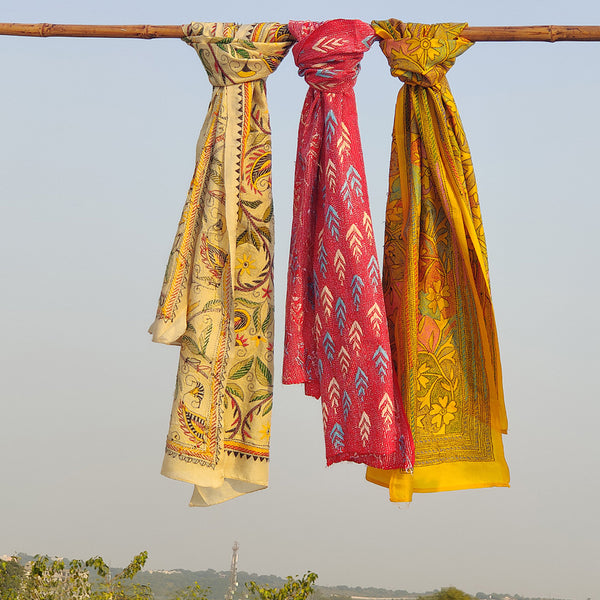The rich cultural Heritage of India is not only reflected in its traditions but also in its textiles. Indian fabrics are famous worldwide and widely known for their craftsmanship, vibrant colours, and intricate designs.
Of all the fabrics available these days, the most cherished ones are Chanderi and Banarasi silk. Both fabrics have a unique history and captivate fashion enthusiasts and designers.
Are you curious to learn more about the two iconic fabrics of India? Fortunately, we have got you back. Here’s everything you need to know about these iconic Indian fabrics, their origin, and history.
What Is Chanderi Fabric?
Chanderi fabric is widely known as one of the best handlooms in India. The fabric became extremely popular among people because of its royalty. The best part about the Chanderi fabric is that it is lightweight and has a glossy transparency and sheer texture. The dresses made from Chanderi fabric seem to be best in hot weather.

History Of Chanderi Fabric
The Chanderi fabric was founded by Lord Krishna’s cousin Shishupal and has been present since the Vedic period. The fabric became popular at the time of the Mughals and used to be in high demand. The evolution of Chanderi fabric started when the weavers replaced handspun yarn with mill-made yarn. Later on, weavers came across Japanese silk and replaced the cotton sarees with Japanese silk.

image credit:- weaver story
Features Of Chanderi Fabric
Chanderi fabric is known for its lightweight nature and sheer texture. A blend of silk and cotton is used in the making of Chanderi fabric giving the fabric its signature transparency. You can easily recognize the Chanderi fabric by its metallic threadwork, intricate motifs, and glossy finish. This fabric is ideal for the ones looking to look royal and luxurious at the same time.
What Is Banarasi Silk?
Banarasi fabric is not something new and has been in existence for centuries and passed down to generations. From spinning the thread to weaving, everything is handmade by experienced artists. A mix of silver and gold was used for delicate silk thread work which in turn also gave it a royal touch.
History
Banarasi silk has its origin in Varanasi, Uttar Pradesh, and was later brought to India by the Mughals. The Banarasi fabric is widely known for its elegance and charm. The modern-day Banarasi fabric includes Persian motifs along with Indian designs. The design of the Banarasi silk not only lures the Indians but also the foreigners.
The Banarasi silk sarees not only include a range of colours but are also heavy on embroidery and designs.

What Is The Process Of Making Banarasi Silk?
The making of the Banarasi silk fabric includes weaving superior quality silk with zari thread and alloys of silver and gold. Back in time, the real silver and gold threads used to be used in the making of the Banarasi silk which is now replaced with artificial gold and silver hue threads to make it cost-effective.
There are different artists for different tasks such as one for weaving thread, the other for dyeing the silk, and the next artist to look after the bundle of silk. Firstly, the design is made onto graph paper which is later used to weave the design into the fabric.
Once done with this, the artists go on to decide on the colour scheme and threads. The popular four varieties of Banarasi silk available these days include organza, Shattir, Katan, and Georgette.

Image Credit:- India currents
What Makes Banarasi A Popular Fabric?
There are plenty of reasons which make Banarasi fabric or Banarasi sarees, the most sought-after fabric in India. Let us take note of those reasons.
Luxury Material
The luxurious texture of the Banarasi silk can be attributed to the pure silk threads used in its making. The silk used in the making is of high quality and adds to the fabric’s richness.
Zari Work
Another reason behind the popularity of Banarasi fabric is the intricate zari work. The zari work is woven into the thread which in turn creates dazzling patterns.
Versatile And Timeless
The best part about Banarasi silk is that it is versatile and timeless. Despite being traditional, it can be adapted to modern fashion and can be worn on multiple occasions such as weddings, festivals, and others.
Deep-Rooted In Tradition
Banarasi silk is deeply rooted in Indian tradition and its cultural significance makes it an integral part of Indian Heritage.

Popular Dresses Made From Banarasi Silk
Are you wondering about the dresses made from Banarasi silk? Itokri has got you covered. Here are some of the popular dresses made from Banarasi silk.
- Sarees
- Lehengas
- Anarkali suits
- Salwar kameez
- Gowns
- Kurtis
Wrapping Up
It would not be wrong to say that Banarasi silk stands as a testament to the legacy of India’s textile traditions. Shop great-looking outfits from iTokri at great prices and make heads turn. Visit our website now.
FAQ’s
How to maintain a Banarasi saree?
Maintaining a Banarasi saree is crucial if you want to make it last long and keep its design intact. Make sure to avoid wearing heavy accessories with the Banarasi saree and store it in a cool and dry place away from all the sunlight.
Out of Chanderi and Banarasi which is a better fabric to wear a saree for marriage?
Both Chanderi and Banarasi sarees are equally good choices for marriage as both have their own unique qualities and appeal. You can decide the one for you depending on your personal preferences, wedding theme, and your comfort.
How do we know it is original Banarasi silk?
Figuring out whether the Banarasi silk is original or not is quite challenging for consumers. Fortunately, you can determine this by checking the GI level, zari work, silk quality, and weave and patterns.



































Leave a comment (all fields required)